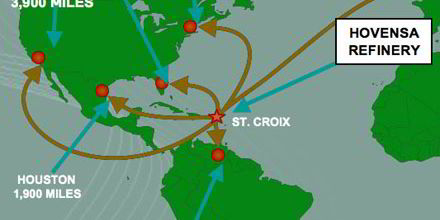US energy giant Hess and Pdvsa of Venezuela are moving forward with a plan to shut the Hovensa refinery in the US Virgin Islands after racking up $1.3bn in losses over the past three years.
The facility, which is located in St Croix, will begin to operate as an oil storage terminal in mid-February, according to a statement.
“Hovensa’s losses have been caused primarily by weakness in demand for refined petroleum products due to the global economic slowdown and the addition of new refining capacity in emerging markets,” Hess told investors Wednesday.
The New York-based oil and gas conglomerate anticipates a $525m charge against fourth-quarter 2011 earnings as a result of the shutdown, which follows closures of at least 18 other refineries in the US and Europe over the past three years.
Before Hovensa cut capacity by 30% to 350,000 barrel-per-day in early 2011 in a bid to reduce costs, the facility was the third largest refinery in the states, according to the US Department of Energy.
Many shipping industry insiders expect the move to have a significant impact on the crude and product tanker markets, including MJLF & Associates analyst Donald Bogden.
Crude and product tanker impact
The researcher says the shutdown, which follows a recent uptick in idling and closures of several refineries on the US East Coast, marks the first termination of a sour crude processing facility as Sunoco Philadelphia, Sunoco Marcus Hook, and Conoco Trainer focused on processing light and sweet grades of West African crude oil.
Bogden believes the market to adjust to the shutdown of Hovensa as Pdvsa intends to maintain production output of 2.5 million barrels per day.
“Thus displaced Venezuelan crude will continue to reach to the market,” he noted. “With other major buyers of Venezuelan crude in the US Gulf refining complex, most notably Citgo, Conoco, and Houston Refining, MJLF expects approximately 90 Kb/d Venezuelan crude will filter into refineries in the US Gulf.”
MJLF estimates the trade flow rebalancing from the closure of Hovensa will positively impact VLCC demand by increasing Venezuelan exports to the Asia Pacific Rim while suezmax and aframax demand will likely remain relatively constant after trade flow adjustments.
As a result, the analyst expects demand for VLCCs to increase by four vessels while one additional aframax may be needed though suezmax demand is unlikely to change.
Bogden told clients: “The shutdown of Hovensa will require product supply into the US to rebalance, with replacement barrels coming from a combination of domestic refineries using Jones Act tonnage and the Colonial Pipeline following its 2012 expansion, European refining exports, and Asia Pacific Rim exports.
“While the allocation between these product sources is complex, MJLF undoubtedly expects the closure of Hovensa will further contribute to the trend of US refinery closures positively impacting product tanker markets.“



